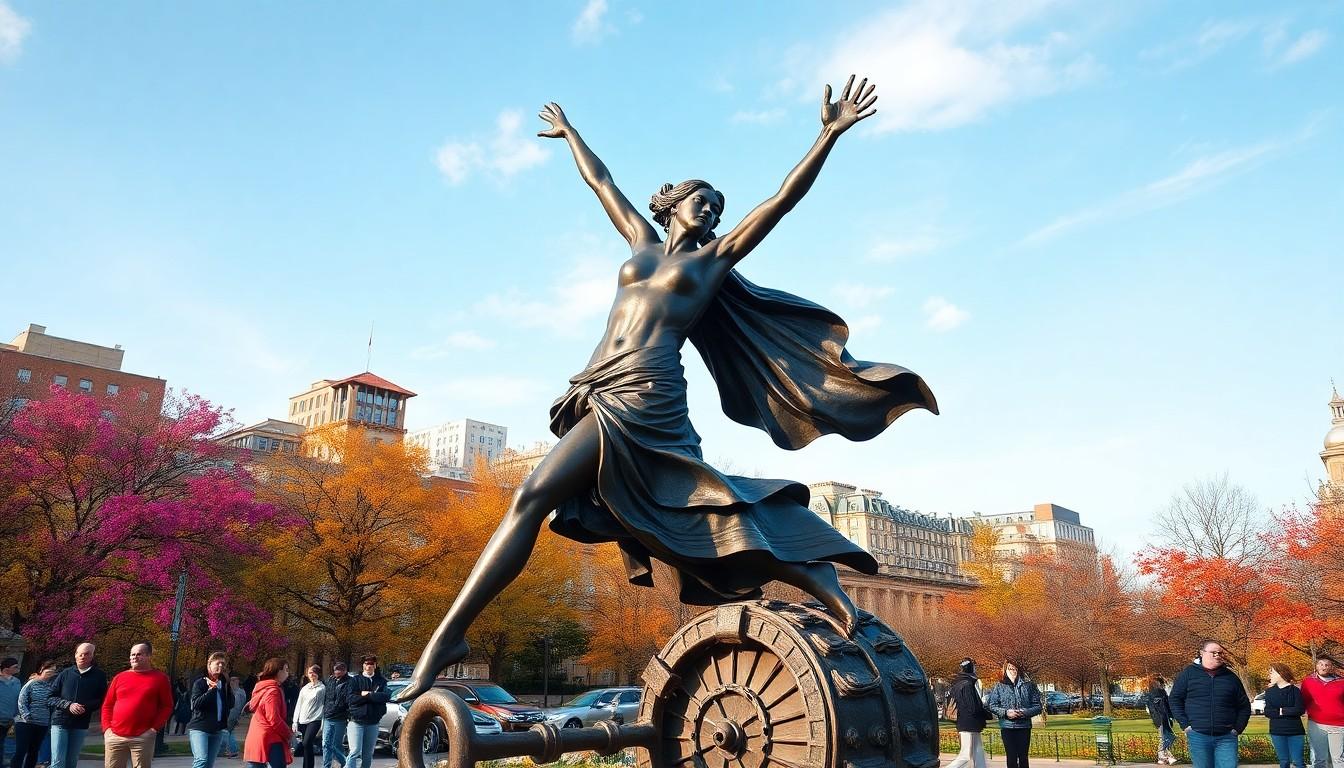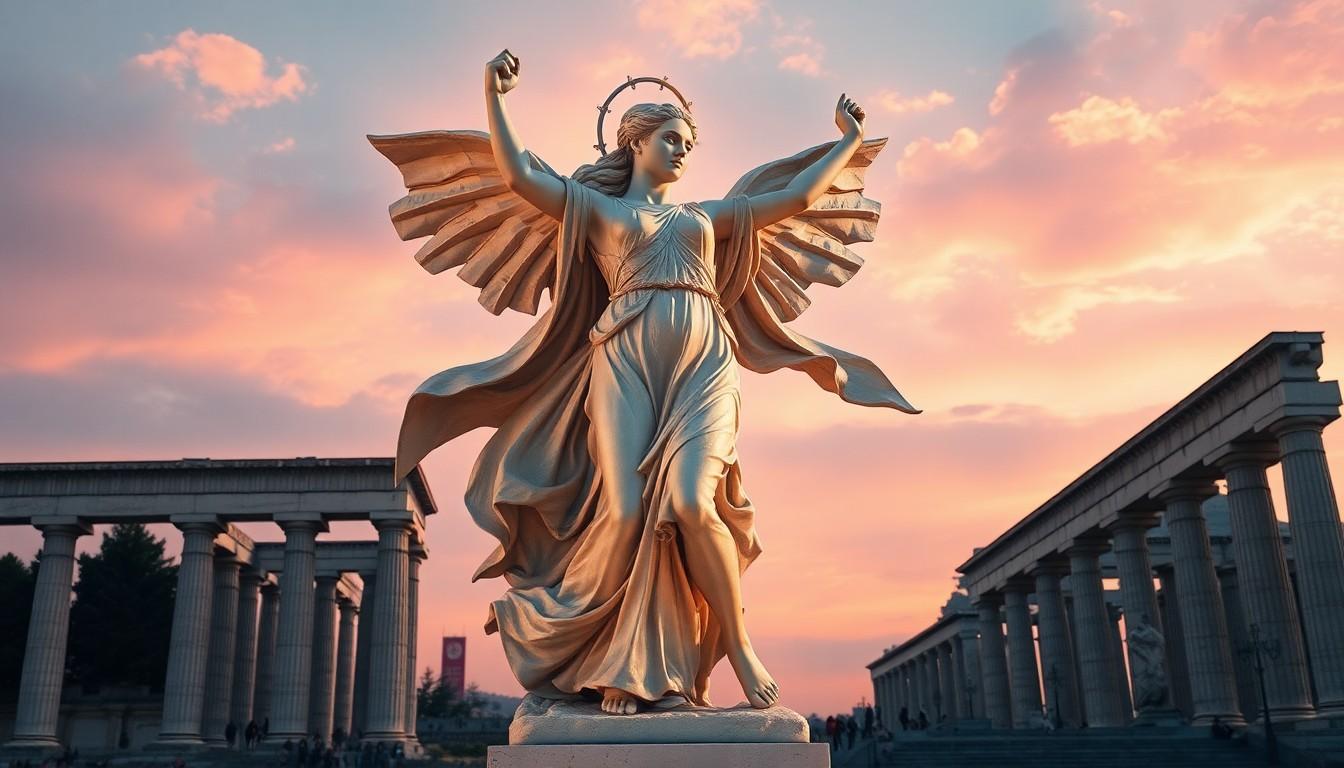
Nike Sculpture: Unleashing the Art of Victory in Movement and Design
When it comes to iconic sportswear, Nike reigns supreme. But what happens when this powerhouse of athletic gear meets the world of art? Enter the Nike sculpture, a stunning fusion of sport and creativity that’ll make you rethink your next workout. This isn’t just another piece of art; it’s a celebration of movement, passion, and, let’s be honest, some seriously stylish sneakers.
Nike Sculpture
Nike sculptures embody the essence of movement, energy, and athletic spirit. Created by various artists, these sculptures often feature dynamic poses that reflect the grace and power associated with sports. Influenced by the culture of athletics, each piece captures the beauty of physicality, while also incorporating elements of design and fashion.
Notable sculptures, such as the Winged Victory of Samothrace, often inspire contemporary interpretations. Artists reinterpret this classic work to highlight modern athletic wear, bridging the gap between historical art forms and modern branding. Sculptures serve not only as art pieces but also as advertisements for the Nike brand, merging creativity with functionality.
Nike sculptures frequently appear at athletic events, galleries, and public spaces. The purpose of these installations ranges from promoting sports initiatives to engaging communities in fitness-related discussions. These artworks challenge viewers to connect with their own athletic passions, encouraging a deeper appreciation for the artistry in sports.
Numerous events showcase Nike sculptures worldwide. From art exhibitions to sporting competitions, the presence of these installations fosters dialogue about athletics and creativity. In this context, the sculptures symbolize much more than just a brand; they represent a lifestyle embraced by athletes and art enthusiasts alike.
Exploration of themes like endurance, motivation, and expression characterizes most Nike sculptures. Each creation aims to inspire individuals to push boundaries and express their identities through movement. Overall, the intersection of art and sport within Nike sculptures enriches both cultural and athletic experiences, prompting reflection on the role of creativity in physical expression.
Historical Background
Nike sculptures represent a significant blend of art and athletics. Their design often captures dynamic movement, reflecting the spirit of sports.
Origins of Nike Sculpture
The origins of Nike sculptures date back to ancient Greece. Nike, the Greek goddess of victory, inspired numerous artistic representations. Statues depicting her often illustrate triumph in battle and sports. The most famous example, the Winged Victory of Samothrace, captures exhilarating motion and divine presence. Artists celebrated her form, sculpting detailed wings and flowing drapery. Works from that era laid the groundwork for modern interpretations embraced by Nike. Contemporary sculptures continue to evoke the essence of victory and athletic spirit.
Influences in Ancient Art
Ancient art heavily influenced the development of Nike sculptures. Greek sculptors emphasized idealized forms and the celebration of physical beauty. Vases, reliefs, and friezes frequently depicted athletes in action, showcasing the importance of sport in their culture. This celebration of the human body informs modern Nike sculpture design. Elements such as proportion and movement remain paramount, echoing age-old themes of victory and perseverance. Each contemporary artwork pays homage to traditions, bridging historical and modern aesthetics. The connection between past and present enriches both art and athletic representation.
Design and Artistic Features
Nike sculptures represent a fusion of athleticism and artistic expression, employing various materials and styles to convey their powerful messages.
Materials Used
Sculptors utilize diverse materials such as bronze, marble, and synthetic composites. Bronze offers durability and a classic aesthetic, often seen in historic depictions of Nike. Marble provides elegance, capturing intricate details that highlight craftsmanship. Synthetic composites allow for innovative designs, enabling flexibility and modern aesthetics. By leveraging these materials, artists create pieces that endure the test of time while appealing to contemporary audiences.
Style and Symbolism
Dynamic poses embody motion, evoking the spirit of athletic achievement. Artists often use flowing lines and exaggerated forms to create a sense of energy. Light and shadow play across the surfaces, enhancing features and adding depth. Symbolism frequently centers around victory, motivation, and human potential, connecting the sculptures to the ideals represented by the brand. Each piece serves not only as art but also as an emblem of inspiration for athletes and spectators alike.
Significance in Culture
Nike sculptures represent a profound intersection of art and athleticism, embodying the spirit of competition and achievement.
Nike as a Symbol of Victory
Nike serves as a powerful symbol of victory and triumph. The goddess encapsulates the essence of winning, widely recognized across cultures. Many sculptures depict dynamic figures that celebrate human achievement in sports. Artists draw inspiration from ancient representations, such as the Winged Victory of Samothrace. Each piece often emphasizes movement and energy, reinforcing its connection to athletic success. Through these sculptures, individuals engage with the motivational themes of accomplishment and determination. Public displays of Nike sculptures resonate with audiences, inspiring them to pursue their own victories in various aspects of life.
Impact on Modern Art
Modern interpretations of Nike sculptures significantly influence contemporary art. Artists integrate diverse materials, including bronze, marble, and synthetic composites, to create innovative designs. The fusion of athleticism and artistic expression challenges traditional boundaries within the art world. Many works highlight themes such as perseverance and the human spirit, making powerful statements on personal and collective achievement. Furthermore, Nike sculptures often appear in galleries and public installations, encouraging discussions on fitness and creativity. This cross-pollination between sports and art fosters a dynamic dialogue about the role of movement in human expression. As a result, the cultural impact of Nike sculptures continues to grow and evolve.
Visiting Nike Sculpture
Visiting Nike sculptures offers a unique blend of art and athletic inspiration. These installations are often situated in prominent locations that enhance their visibility and accessibility.
Locations and Accessibility
Nike sculptures can be found in various locations, including urban parks, athletic venues, and museums. Major cities, such as New York and Los Angeles, frequently showcase these pieces in public spaces. Local events often integrate Nike sculptures, creating a vibrant atmosphere that captivates visitors. Accessibility is generally good, with many artworks located near public transportation and pedestrian pathways. Some locations even provide guided tours to enhance the visitor experience.
Visitor Experience
Experiencing Nike sculptures immerses individuals in the world of art and athleticism. Vibrant settings surrounding these sculptures enhance their emotional impact, inviting viewers to engage with the dynamic forms. Interactivity may include guided tours, informative placards, and occasional workshops that deepen appreciation of these works. Visitors often find themselves inspired by the themes of victory and motivation that resonate throughout the designs. Opportunities for photography abound, allowing individuals to capture their encounters with these iconic representations of human achievement.
Art and Athletics
Nike sculptures stand as powerful symbols of the intersection between art and athletics. They embody the spirit of competition and the celebration of human achievement. Through dynamic poses and innovative materials, these artworks inspire individuals to connect with their athletic passions while fostering a dialogue about creativity and movement.
As they continue to evolve, Nike sculptures maintain their cultural significance, encouraging a deeper appreciation for both sports and artistic expression. Their presence in public spaces and galleries invites communities to engage with the messages of motivation and perseverance that resonate within each piece. Ultimately, these sculptures not only represent a brand but also encapsulate the essence of victory and the human experience.
